William Goodwin was born at Blandford, Dorset in 1820, beginning his working life as a maltster before turning his hand to training in 1845. By 1848 he had transferred to Newmarket, training on The Severals for George Hobson, and soon attracted other prominent owners, including T H Forth, son of the more famous John Forth. In 1850 he won the Epsom Oaks with Rhedycina (SR 1840), owned by George Hobson, renaming the Cottage on the Severals, Rhedycina Cottage, which he was living in at the time. In later years other residents of the house were Richard Cotton and Henry Jennings. In 1854 he won the Epsom Oaks for a second time with Mincemeat (SR 1825), owned by William Cookson and ridden by Jack Charlton. By 1855 he mad moved to Phantom Cottage where he became a public trainer.In November 1866 Goodwin moved to larger premises, the newly built Waterwitch House, which proved to be his final stable. The stables, owned by Mr Bryan, wre named after a notorious mare of his called Waterwitch, which briefly resulted in him being warned off in 1861, but he had then bought Rutland Cottage in 1863, took an additional 13 box yard which was formerly occupied by Mr Ten Broeck, and created Waterwitch House.
William Arthur Jarvis, born in Newmarket in 1852, lived for a while in his youth at the Greyhound Inn where his grandfather, also called William, was listed as the Innkeeper, and after a moderately successful career as a jockey he turned to training as young as 18 years old. He trained at Waterwitch House in Newmarket after the death of William Goodwin, although he was also closely associated with Sackville House Stables in later life. He married the 21-year-old Leonora Godding, daughter of trainer James ‘Jem’ Godding, on 6th September 1884 at All Saints Church, and they had 3 sons, all of which became well-regarded trainers in their own right; Willie Jarvis, Jack Jarvis and Basil Jarvis. He initially concentrated on National Hunt horses, but when the wealthy banker and MP Sir Charles Day Rose supported him, Jarvis flourished as a Flat race trainer, and the pair enjoyed tremendous success. Although he trained just one Classic winner, training Bona Vista, bought as a yearling for just 1250 guineas, to win the 1892 2000 Guineas, he acknowledged that his favourite horse was Cyllene, who won the 1898 Jockey Club Stakes and, a year later, captured the Ascot Gold Cup for supportive owner Charles Day Rose. His greatest disappointment, which could so easily have been his greatest success had it not been for Isinglass, was Ravensbury. The horse was runner-up in no less than 3 classics and, to add salt to the wound, filled the same runner-up spot in the Grand Prix de Paris. At the start of the 1893 season Jarvis had high hopes for Ravensbury, for the colt had run well towards the end of his two-year-old career. It was third to Isinglass in the New Stakes at Ascot, but then won the Great Lancashire Breeders Produce Stakes when ridden by Fred Webb, so the scene was set in the Middle Park Plate, although the colt was, once again, opposed by Isinglass. In the event Isinglass (10/1) defeated Ravensbury (20/1) by a length to affirm his superiority and go into the Winter as Derby favourite. In the 1893 2000 Guineas Ravensbury (100/7), ridden by Henry Arthur Barker, was beaten 3/4 length by Isinglass. In the Epsom Derby Ravensbury (25/1) was beaten a length by Isinglass (SR 2047), while in the St Leger Ravensbury (11/2) was, once again, opposed by Isinglass who claimed the Triple Crown, winning cosily by half a length.
For over 4 centuries racing has been staged in Newmarket, but how have the racecourses evolved from an initial starting point at Fleam Dyke Pumping Station, some 8 miles from the town, with a winning post barely 200 metres from the town centre, into two world recognized, excellent racecourses and a universal acceptance that Newmarket is the Headquarters of racing?
To access an interactive racecourse map showing over 50 individually named racecourses CLICK HERE. The map will enable you to:-
1. Determine when extended races over 8 miles, 6 miles and 4 miles began to be replaced by the courses now visited by thousands annually;
2. Consider how the challenge of crossing the Devil's Dyke was overcome;
3. Contemplate why the town no longer has a steeplechase course despite having at least 5 courses during the past 2 centuries;
4. Examine the practicalities of having up to 48 starting posts and winning posts;
5. Appreciate that it was not financially viable to have an open racecourse spread widely across the heath, with a finishing post barely 200 metres from the town centre;
6. Research how and why the Cambridgeshire Handicap has been contested over 3 different courses.
NOTE: The map does not make mention of 2 particular courses:-
(i) Sefton Course (also known as the Cambridge Road Course)
Source: 1970 Raceform. Used from 1959 to 1975.
(ii) New Circular Course
The Circular Handicap was run on Friday 29th October 1875 on the New Circular Course of about two miles.
Source: London Standard (30th October 1875): ''the horses started near the Turn of the Lands, ran back way of the Cambridgeshire Course towards the Ditch, and afterwards proceeded down the side of the Tan Gallop, and turned into the Rowley Mile near the Bretby Stakes starting post, finishing at the stand at the end of the flat. Except in the hollow near the Cambridgeshire start the runners should have been visible all the way if the sky had been bright and clear''.
Another report hoped that the Circular Handicap would become a feature in future programmes, as it would be contested in front of the new grandstand which would be completed in about a year and would be able to accommodate thousands.
(I am grateful to Tim Cox for bringing attention to these 2 courses.)
Enjoy researching the intriguing history of Newmarket and its many racecourses.
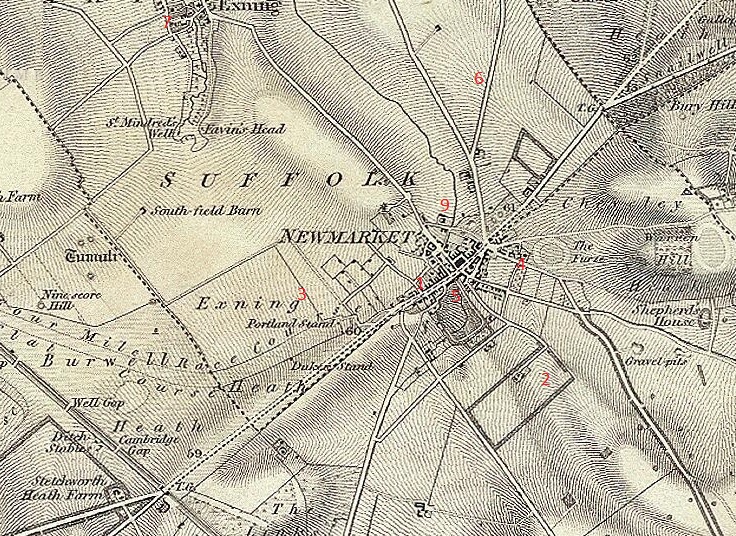
In the 1893 Grand Prix de Paris at Longchamp, Ravensbury played second fiddle yet again to Ragotsky, owned by Baron A de Schickler, trained by William Webb and ridden by A E Dodge. For 5 years William Jarvis was assisted by his son Jack, who later went on to great things at Park Lodge, winning the 1939 2000 Guinas and Derby with Blue Peter. In 1916 William, aged 64, transferred to Sackville House. On Tuesday 6th December 1921 William Jarvis, well-respected trainer based at Sackville House, died after a long illness. He was one of the oldest trainers in Newmarket, regarding Cyllene as the best horse he ever trained, and was part of the Jarvis dynasty. In his will, William Arthur Jarvis left property to the value of £5657.
1892 2000 Guineas BONA VISTA (SR 1905) 10/1 owned by Charles Day Rose, trained by William Jarvis and ridden by Willie Robinson
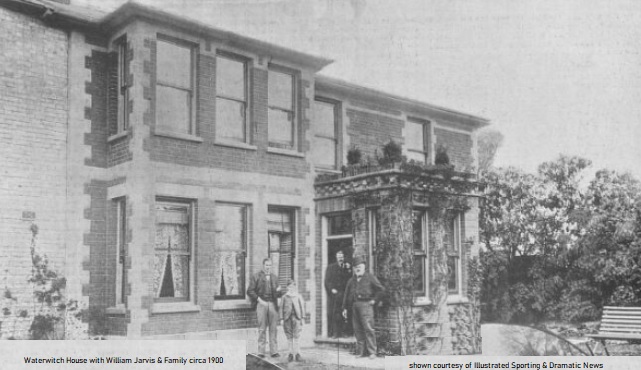
1897 National Breeders Produce Stakes at Sandown CYLLENE owned by Charles Day Rose, trained by William Jarvis and ridden by Sam Loates
1898 Newmarket Stakes CYLLENE owned by Charles Day Rose, trained by William Jarvis and ridden by Sam Loates
1898 Jockey Club Stakes CYLLENE owned by Charles Day Rose, trained by William Jarvis and ridden by Sam Loates
1899 Ascot Gold Cup CYLLENE owned by Charles Day Rose, trained by William Jarvis and ridden by Sam Loates
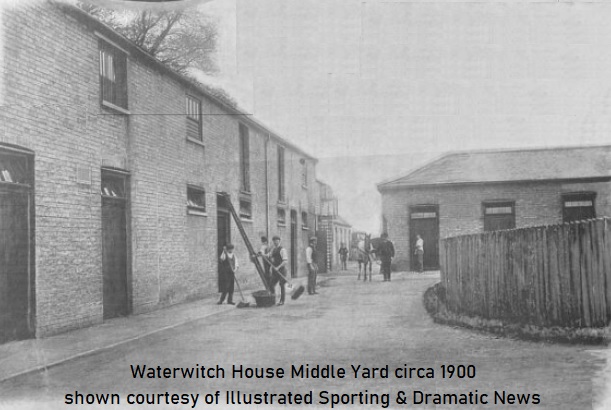
1917-November 1920 Robert Weston Colling
Robert Weston Colling, born in Marske-By-Sea in North Yorkshire on 6th April 1872, was the son of a farmer who enjoyed his hunting, so it was no surprise that Robert became an apprentice to Robert W Armstrong at Penrith. He had a successful riding career, winning the 1890 July Cup aboard Lord Penrhyn's Queen of the Fairies, winning the Stewards Cup two years later when partnering the Duke of Devonshire's Marvel, and crowned his career by landing the 1894 Northumberland Plate on Newcourt, the 5/4 favourite. He married Alice Louise L'Anson, second daughter of the handicapper, Robert L'Anson, on Monday 12th June 1899 at St Mary's Church, Ewell. He began his training career in Yorkshire, and by 1911 was based at Spigot Lodge, Middleham, but he moved to Newmarket in 1917 to continue his training career at Waterwitch House, replacing William Jarvis, before moving on to Bedford Lodge Stables in 1920. During his time at Waterwitch House Stables he won the 1917 Select Stakes at Newmarket with Major R L Kidston's Quarryman, the 1919 Yorkshire Oaks with Mademoiselle Foch for Major J Paget, and the 1920 Northumberland Plate, for which he was a specialist both as a rider and a trainer, with Colonel C Hopkins Irish Lake. He later went on to trained the winner of the Cambridgeshire in 1944 and 1945 with Hunsingore and Esquire respectively. He carried on training until late in life, dying on 25th May 1960 aged 88.
1890 July Cup QUEEN OF THE FAIRIES 7/1 owned by Lord Penrhyn, trained by Allen and ridden by Robert Colling
1892 Stewards Cup MARVEL 1000/45 owned by the Duke of Devonshire, trained by Marsh and ridden by Robert Colling
1894 Northumberland Plate NEWCOURT 5/4 fav owned by P Buchanan and ridden by Robert Colling
1917 Select Stakes at Newmarket QUARRYMAN 4/1 owned by Major R L Kidston, trained by R W Colling and ridden by George Colling
1917 Higham Handicap at Newmarket QUARRYMAN 3/1 owned by Major R L Kidtson, trained by R W Colling and ridden by George Colling
1917 Saxham 2-year-old Plate at Newmarket BRIDGE OF WEIR 5/2 owned by Major Kidston, trained by R W Colling and ridden by George Colling
1918 Autumn Stakes THE PANTHER 5/4 fav owned by Sir A Black, trained by R W Colling and ridden by George Colling
1918 Royston Handicap KAFFIR KING 6/1 owned by Major Kidston, trained by R W Colling and ridden by George Colling
1919 Atalanta Stakes DOUBLE NOTE 4/6 fav owned by Major Kidston, trained by R W Colling and ridden by George Colling

1919 Cotton Stakes at Manchester WOODROW 4/5 fav owned by Mr C Garland, trained by R W Colling and ridden by George Colling
1920 Triennial Produce Stakes SERAPH 5/1 owned by Major Kidston, trained by R W Colling and ridden by George Colling
1920 Northumberland Plate IRISH LAKE 7/2 fav owned by Colonel C Hopkins, trained by R W Colling and ridden by P Jones
1944 Cambridgeshire HUNSINGORE 6/1 owned by Major L B Holliday, trained by R W Colling and ridden by Harry Wragg
1945 Cambridgeshire ESQUIRE 40/1 owned by J Bueno, trained by R W Colling and ridden by G Packer
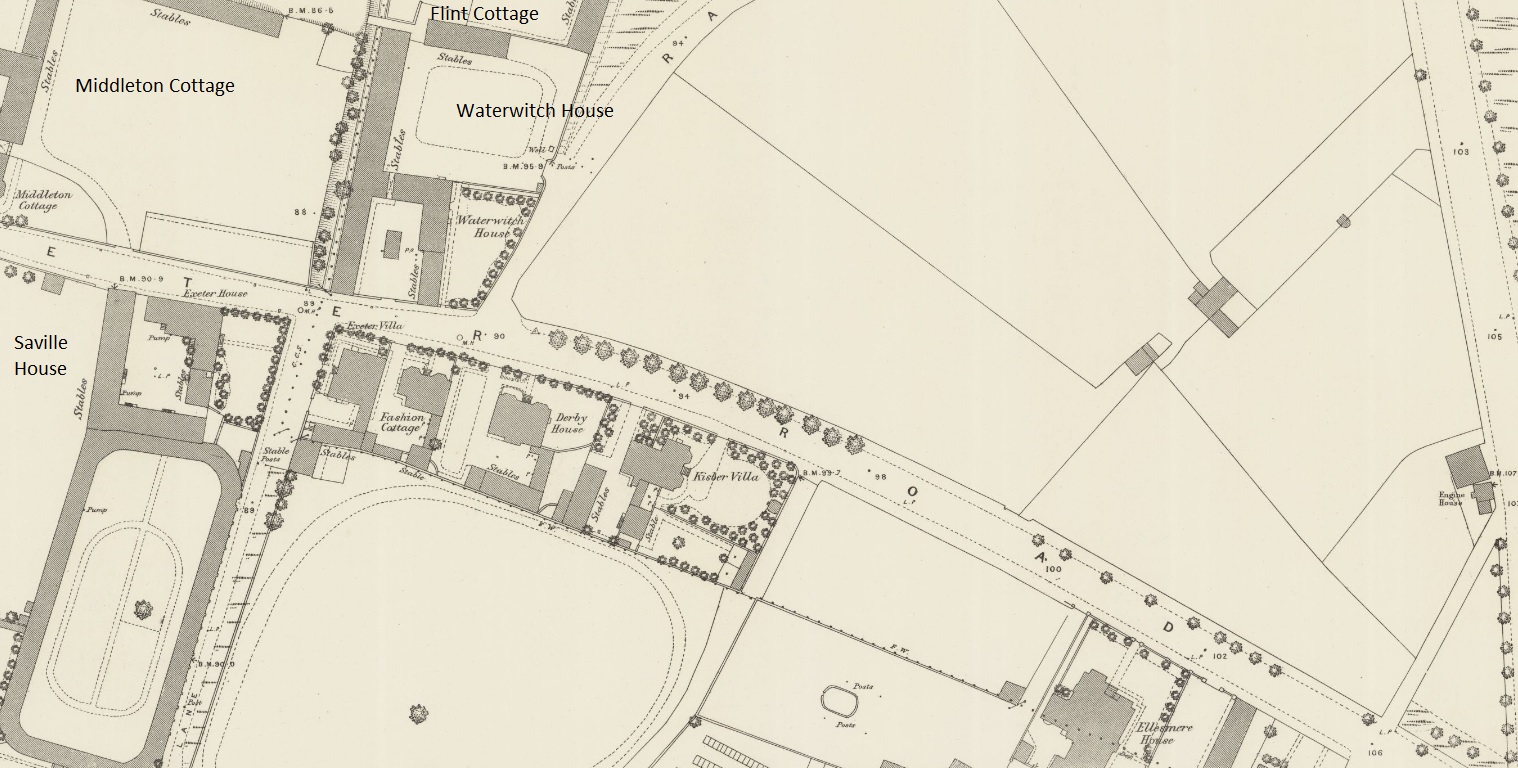
November 1920-January 1923 Tom Green, Sir George Noble
After Robert Weston Colling had departed for Bedford Lodge, Waterwitch House was leased by trainer Tom Green, financially supported by Sir George Noble. The property was put up for auction in May 1921 but failed to find a bidder. Stable stars, during his brief stay at Waterwitch House, were Polemarch (SR 1854), shock 50/1 winner of the 1921 St Leger for the 7th Marquis of Londonderry, Premium Bond and Dorset. In January 1923 Green left Newmarket for Stapleton Park, Doncaster, providing Hugh Powney with the opportunity to move to Waterwitch House.
1921 Knowsley Dinner Stakes at Liverpool POLEMARCH 1/2 fav owned by 7th Marquis of Londonderry, trained by Tom Green and ridden by Steve Donoghue
1921 Great Northern St Leger at Stockton POLEMARCH 4/6 fav owned by Lord Londonderry, trained by Tom Green and ridden by Joe Childs
1921 St Leger POLEMARCH (SR 1854) 50/1 owned by 7th Marquis of Londonderry, trained by Tom Green and ridden by Joe Childs
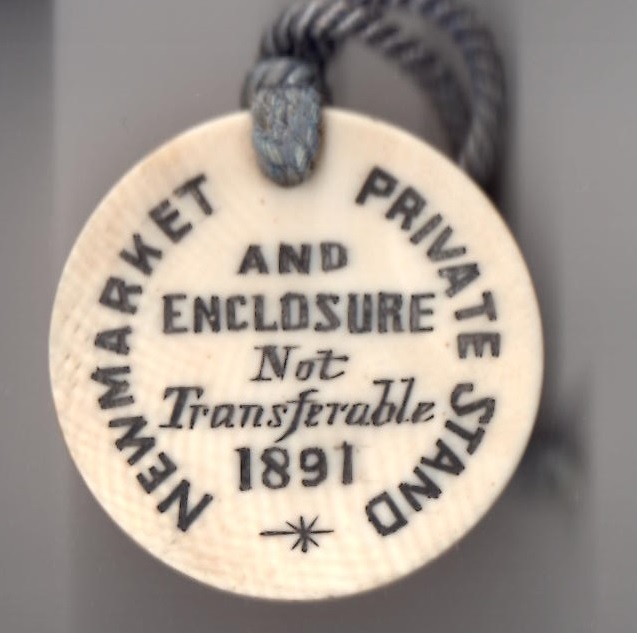
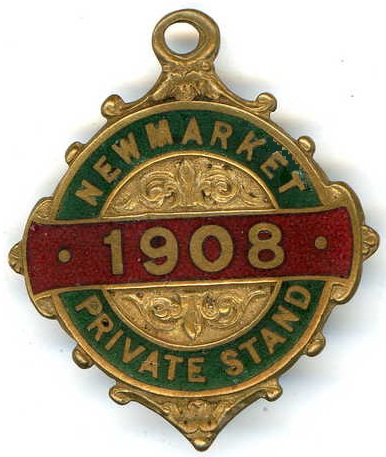
February 1923-November 1933 Hugh Powney
Hugh Powney was destined to become a racehorse trainer, for his father taught him the art of reading pedigree lines from an early age. His father, John, lived his entire life in the same house at Lansdown, Bath, being born and dying in the exact same room in May 1894. He owned racehorses for over 50 years, and is widely, but incorrectly, reported to have owned the staying horse The Hero, when he won the 1847 Goodwood Cup. However, the Racing Calendars and all newspapers at that time record John Day as the owner, with John Powney not owning him until he was 6-years-old. As a 3-year-old, the chestnut colt The Hero ran in the colours of John Day when second at 4/1 favourite in the Goodwood Stakes behind Jonathan Wild on Wednesday 29th July 1846. On Friday 14th August 1846 The Hero won 2 consecutive races for John Day at Salisbury, winning the Salisbury Handicap from Miss Shirley when ridden by A Day, and then walking over in the Salisbury Gold Cup over 2 miles. He won the Dundas Stakes, His Majesty's Plate and the County Cup at York in August. He opened his 4-year-old account at Ascot Heath on Thursday 3rd June 1847 wearing the colours of John Day in His Majesty The Emperor of Russia's Plate, beating Wolf-dog when 6/4 joint favourite. However, the pinnacle of his career was reached on Thursday 29th July 1847, still in the ownership of John Day, when The Hero won the Goodwood Cup (4/5 fav) over 2 3/4 miles from Eryx. As a 5-year-old in 1848 he won again at Goodwood for John Day, but he was bought by John Powney in 1849 as a six-year-old and ran down the field in 6th behind Lord Stanley's Canezou in the Goodwood Cup on Thursday 2nd August 1849. Hugh assisted his brother John at Grateley before going on to assist Major Bewicke. He then was appointed private trainer to Sir Ernest Cassel at Moulton Paddocks, although Sir Ernest died on 21st September 1921. Hugh then became a public trainer at Waterwich House, Newmarket in February 1923, although in January 1923 he occupied a few boxes at Osborne House, leased from Ellen Chaloner. He remained at Waterwitch House for 10 years, during which time he was married on Wednesday 21st December 1927 to Constance Manning at St Mary's Church, Kensington, London. In 1925 he trained Pons Asinorum to win the Phoenix Plate for Mr A Loury, although the colt was thought good enough to contest the 1925 St Leger, but ran unplaced behind Solario (SR 2026). Hugh departed Waterwitch House in November 1933 bound for Jevington, Sussex.
1921 Fulbourne Stakes GOLDEN CORN 13/8 fav owned by Marshall Field, trained by Hugh Powney and ridden by Steve Donoghue
1921 Prince of Wales Plate GOLDEN CORN 4/7 fav owned by Marshall Field, trained by Hugh Powney and ridden by Steve Donoghue
1921 Champagne Stakes GOLDEN CORN 11/10 fav owned by Marshall Field, trained by Hugh Powney and ridden by Joe Childs
1921 Middle Park Stakes GOLDEN CORN 2/7 fav owned by Marshall Field, trained by Hugh Powney and ridden by Steve Donoghue
1922 Southfield Plate YOUNG POLE 10/1 owned by Lady Nunburnholme, trained by Hugh Powney and ridden by Steve Donoghue
1924 Phoenix Plate PONS ASINORUM 3/1 fav owned by Mr A Loury, trained by Hugh Powney and ridden by J Ledson
1934-1935 W J Clark
After Hugh Powney left Waterwitch House in November 1933 it became the property of Mr W J Clark. He died, and in June 1935 Messrs Griffiths were instructed to sell the House and racing establishment, the whole consisting of a large house with 8 bedrooms and stabling for 46 horses.
October 1949 Geoff Barling
There were long periods when Waterwitch House was not used as stables, but in October 1949 Geoff Barling took over just 8 boxes for a short while in addition to his stables at Primrose Cottage.
Present
For some considerable time the stables have been replaced by offices and flats.
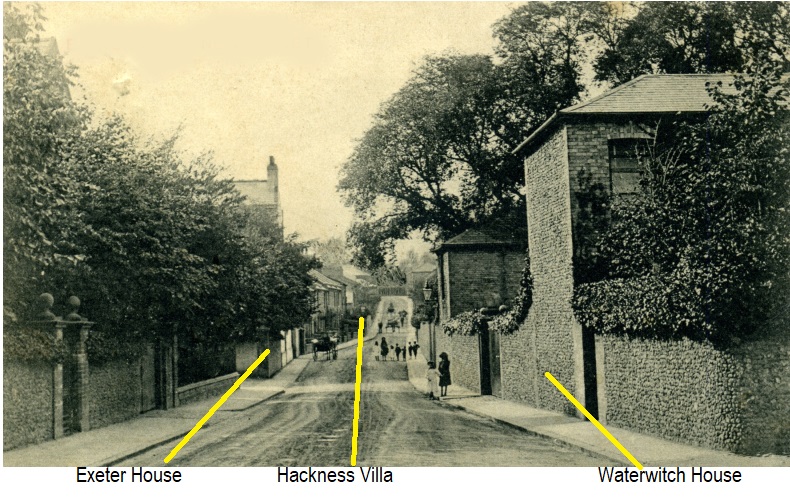
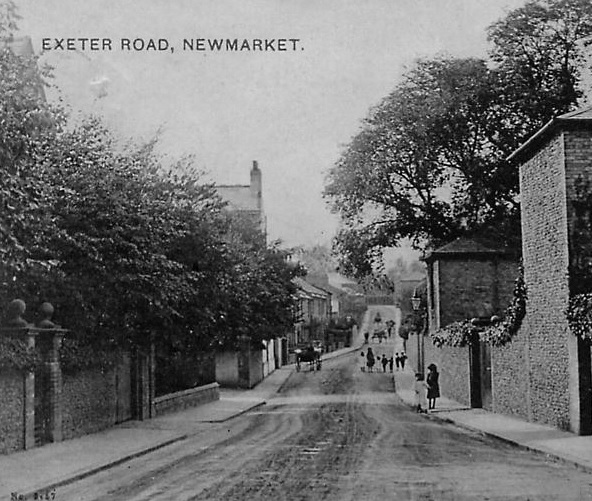
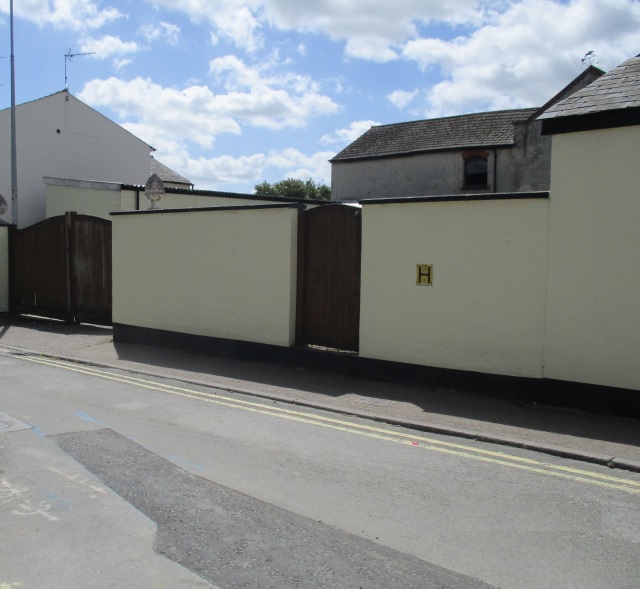
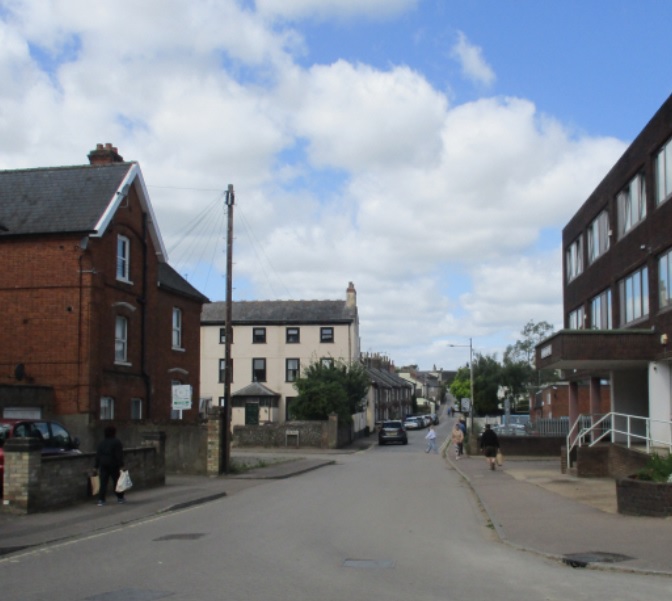
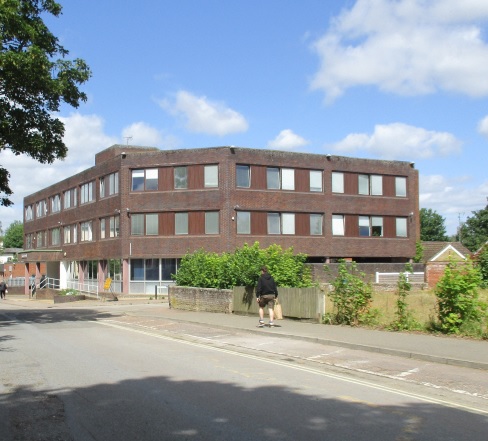
CYLLENE (1899 Ascot Gold Cup, 1898 Jockey Club Stakes)
RAVENSBURY (Runner-up in 1893 2000 Guineas, Epsom Derby, St Leger, Grand Prix de Paris)
BONNA VISTA (1892 2000 Guineas)
POLEMARCH (1921 St Leger)
MADEMOISELLE FOCH (1919 Yorkshire Oaks)



